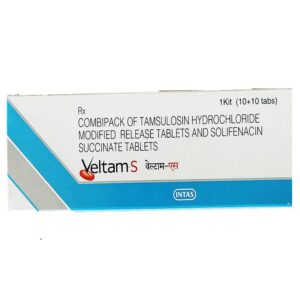TAMSULOSIN + HYDROCHLORIDE + MODIFIED RELEASE + SOLIFENACIN
Tamsulosin: Tamsulosin is a medication commonly prescribed for the treatment of symptoms related to an enlarged prostate, also known as benign prostatic hyperplasia (BPH). It is sold under brand names such as Flomax, Harnal, and Contiflo.
Tamsulosin belongs to a class of drugs called alpha-1 blockers. It works by relaxing the smooth muscles in the prostate gland and the bladder neck, which helps improve urinary flow and reduce symptoms of BPH. It specifically targets the alpha-1 adrenergic receptors in these areas.
The usual recommended dose of tamsulosin for BPH is 0.4 mg once a day. It is usually taken orally with or without food. It is important to take tamsulosin at the same time each day to maintain a consistent level of the medication in the body.
Common side effects of tamsulosin include dizziness, lightheadedness, drowsiness, weakness, headache, and abnormal ejaculation (such as decreased semen volume or retrograde ejaculation, where semen enters the bladder instead of exiting the penis during ejaculation). These side effects are usually mild and temporary, but if they persist or worsen, it is important to consult a healthcare professional.
In some cases, tamsulosin can cause a sudden drop in blood pressure, especially with the first dose or when rising quickly from a sitting or lying position. This can lead to fainting or dizziness. To minimize the risk, it is recommended to take the first dose of tamsulosin at bedtime and avoid abrupt changes in position.
Rare but serious side effects of tamsulosin may include a prolonged or painful erection (priapism), severe allergic reactions, and symptoms of liver injury (such as yellowing of the skin or eyes, dark urine, abdominal pain). If any of these occur, medical attention should be sought immediately.
It is important to note that tamsulosin is primarily used for the treatment of BPH and its associated symptoms. It is not effective for the treatment of high blood pressure or prostate cancer. The drug should be used under the supervision and guidance of a healthcare professional.
Hydrochloride: Hydrochloride is not a specific drug; it is a common salt form of various medications. However, I can provide information about a drug that includes the term “hydrochloride” in its name. One example is Ondansetron Hydrochloride, a medication commonly used to prevent nausea and vomiting caused by chemotherapy, radiation therapy, or surgery.
Use: Ondansetron Hydrochloride is primarily used to prevent and treat nausea and vomiting induced by cancer chemotherapy, radiation therapy, or surgical procedures. It belongs to a class of drugs called antiemetics.
Mechanism of Action: Ondansetron works by blocking certain serotonin receptors in the brain, specifically the 5-HT3 receptors. By inhibiting the action of serotonin, a neurotransmitter implicated in triggering nausea and vomiting, on these receptors, it helps to reduce or prevent these symptoms.
Dose: The recommended dosage of Ondansetron Hydrochloride varies depending on the indication and the patient’s age. For the prevention of chemotherapy-induced nausea and vomiting, the typical adult oral dose is 8 mg taken 1 to 2 hours before treatment, followed by two additional 8 mg doses 8 hours apart. The maximum daily dose should not exceed 32 mg. Dosages may differ for children and individuals with specific medical conditions, so it is crucial to consult a healthcare professional for personalized dosing instructions.
Side Effects: Common side effects of Ondansetron Hydrochloride include headache, constipation, diarrhea, dizziness, fatigue, and drowsiness. Some individuals may also experience a transient elevation of liver enzymes or allergic reactions like rash or itching. In rare cases, it may cause a serious condition called serotonin syndrome, characterized by agitation, hallucinations, rapid heartbeat, fever, muscle stiffness, and tremors. It is important to seek immediate medical attention if any severe or unusual side effects occur.
Please note that this is just one example of a drug containing “hydrochloride” in its name. Other medications with the hydrochloride salt form will have different uses, mechanisms of action, dosages, and side effects.
Modified Release: I’m sorry, but “Modified Release” is not a specific drug name. Could you please provide the name of the drug you’re referring to?
Solifenacin: Solifenacin is a medication commonly used to treat overactive bladder.
The drug works by blocking the action of a specific receptor, called the M3 muscarinic receptor, found in the bladder. By blocking this receptor, solifenacin helps to relax the bladder muscle and reduce the frequency of urinary urgency, urination, and incontinence.
Solifenacin is typically taken orally and the usual starting dose is 5 mg once daily. In some cases, if the desired effect is not achieved, the dose may be increased to 10 mg once daily.
As with any medication, solifenacin has potential side effects. The most common side effects include dry mouth, constipation, blurred vision, and difficulty emptying the bladder completely. Some individuals may also experience headache, dizziness, abdominal pain, or dry eyes. In rare cases, solifenacin may cause more serious side effects such as urinary retention or allergic reactions. It is important to consult with a healthcare professional if any concerning side effects occur.
Solifenacin should be used with caution in individuals with certain medical conditions like uncontrolled narrow-angle glaucoma, severe gastric retention, or urinary outflow obstruction. It may also interact with other medications, so it is important to inform the healthcare provider about any other drugs being taken.
Overall, Solifenacin is an effective medication for the treatment of overactive bladder, but it is important to weigh the benefits against the potential side effects and discuss with a healthcare professional before starting this medication.

